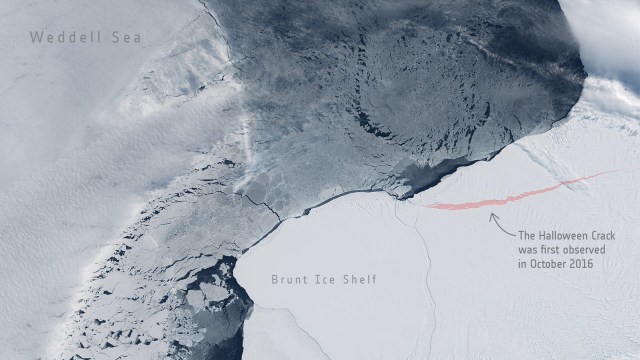What is Halloween Crack?
Although iceberg calving is normal, the Brunt Ice Shelf is feeling the same pressures as elsewhere around Antarctica, including low sea ice conditions.
 Iceberg A-83 was first spotted off the Brunt Ice Shelf in the eastern Weddell Sea. (The European Space Agency)
Iceberg A-83 was first spotted off the Brunt Ice Shelf in the eastern Weddell Sea. (The European Space Agency) A large iceberg, measuring 375 square kilometres, broke off from Antarctica’s Brunt Ice Shelf last week. As per the European Space Agency, this was the region’s third significant iceberg calving in the past four years.
The iceberg that broke off was named A-83, and Christopher Shuman, a glaciologist based at NASA’s Goddard Space Flight Center, estimated that the iceberg measures about 375 square kilometres (145 square miles).
Iceberg A-83 was first spotted off the Brunt Ice Shelf in the eastern Weddell Sea. It broke from a rift known as the “Halloween Crack”. Although iceberg calving is normal, the Brunt Ice Shelf is feeling the same pressures as elsewhere around Antarctica, including low sea ice conditions. When less sea ice is present, ice shelves are more exposed to destabilising wind and wave action.
Here’s all about the Halloween Crack
📌 First spotted on 31 October 2016, the Halloween Crack runs from an area known as McDonald Ice Rumples – which is where the underside of the floating ice sheet is grounded on the shallow seabed. This pinning point slows the flow of ice and fractures the ice surface.
📌 The Halloween Crack, which is currently stable, runs adjacent the more precarious tip of Brunt Ice Shelf. This tip of the shelf is hanging by a thread – now only held in place by a narrow strip of ice around 600 m long at the northern end of the long chasm cutting through the western and remaining eastern part of the ice shelf.
📌 If and when this potential rupture point finally gives way, it is expected to spawn a huge iceberg about 1750 square kilometres.
📌 The McDonald Ice Rumples are the result of ice that flows over an underwater obstruction, where the bedrock rises high enough to reach into the underside of the floating ice shelf. This rocky formation impedes the flow of ice and causes pressure waves, crevasses, and rifts to form at the shelf’s surface.
(With inputs from the LandSat NASA and European Space Agency)







